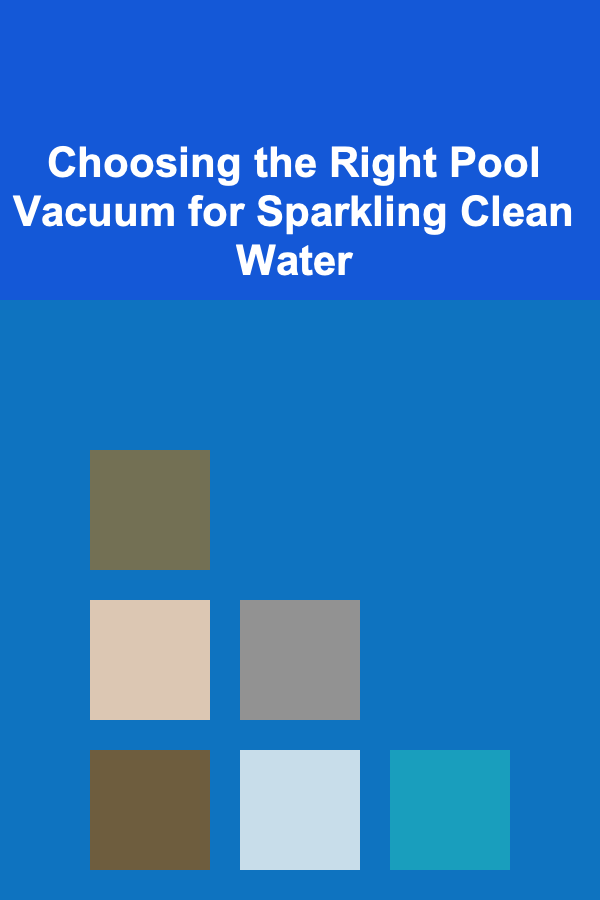
Choosing the Right Pool Vacuum for Sparkling Clean Water
ebook include PDF & Audio bundle (Micro Guide)
$12.99$6.99
Limited Time Offer! Order within the next:

Maintaining a pristine swimming pool is essential for enjoyment and safety. A crucial aspect of pool maintenance is effectively removing debris, algae, and other contaminants from the pool floor and walls. This is where a pool vacuum comes into play. However, with a vast array of options available, selecting the right pool vacuum can seem daunting. This comprehensive guide will delve into the different types of pool vacuums, factors to consider when making your choice, and tips for optimal operation, ensuring you achieve consistently sparkling clean water.
Understanding the Importance of Pool Vacuuming
Before diving into the specifics of different pool vacuums, it's important to understand why regular vacuuming is necessary. While filtration systems and pool skimmers play a vital role in removing surface debris and finer particles, they often can't handle heavier debris that settles on the pool floor. This settled debris can include leaves, dirt, sand, algae, and other organic matter. If left unattended, this accumulation can lead to several problems:
- Reduced Water Clarity: Debris clouds the water, making it less appealing and potentially hindering visibility, which can be a safety concern.
- Algae Growth: Organic matter provides a breeding ground for algae, leading to green or murky water, requiring additional chemical treatments and potentially closing the pool.
- Increased Chemical Consumption: Debris consumes chemicals like chlorine, making it harder to maintain proper water balance and requiring more frequent and costly chemical additions.
- Staining: Certain types of debris, like leaves or berries, can stain the pool surface, requiring specialized cleaning products and potentially damaging the pool liner.
- Clogged Filters: Excessive debris overwhelms the filtration system, potentially clogging the filter and reducing its efficiency.
Regular vacuuming prevents these issues, ensuring a clean, healthy, and enjoyable swimming environment.
Types of Pool Vacuums: A Comprehensive Overview
Pool vacuums can be broadly categorized into three main types: manual vacuums, automatic pool cleaners (suction-side, pressure-side, and robotic), and built-in pool cleaning systems. Each type offers different advantages and disadvantages, catering to various pool sizes, budgets, and cleaning preferences.
1. Manual Pool Vacuums
Manual pool vacuums are the most basic and affordable option. They consist of a vacuum head, a telescopic pole, and a vacuum hose. The vacuum head is manually guided across the pool floor and walls, sucking up debris through the hose, which is connected to the pool's skimmer or a dedicated vacuum line. The debris is then filtered through the pool's existing filtration system.
Pros:
- Affordable: Manual vacuums are the least expensive option, making them ideal for budget-conscious pool owners.
- Control: You have complete control over the cleaning process, allowing you to target specific areas and stubborn debris.
- Suitable for Small Pools: Manual vacuums are well-suited for smaller pools or spas where the cleaning area is limited.
- No Additional Power Source Required: They rely on the pool's existing filtration system and don't require electricity.
Cons:
- Labor-Intensive: Requires manual effort and can be time-consuming, especially for larger pools.
- Skimmer Dependency: Relies on the pool's skimmer basket to collect debris, which may require frequent emptying during vacuuming.
- Limited Coverage: Can be challenging to reach all areas of the pool, especially corners and steps.
- Not Ideal for Heavy Debris: May struggle to handle large amounts of debris or heavier items like rocks.
Ideal for: Small to medium-sized pools, infrequent cleaning needs, budget-conscious pool owners who are willing to invest the time and effort.
2. Automatic Pool Cleaners (APCs)
Automatic pool cleaners offer a more hands-free approach to pool cleaning. They automate the vacuuming process, allowing you to spend less time on pool maintenance. APCs are further divided into three subcategories:
a. Suction-Side Pool Cleaners
Suction-side cleaners are the most common type of automatic pool cleaner. They connect to the pool's skimmer or a dedicated vacuum line and use the suction power of the pool pump to move around the pool and vacuum up debris. The debris is then filtered through the pool's existing filtration system.
Pros:
- Relatively Affordable: Suction-side cleaners are generally less expensive than pressure-side or robotic cleaners.
- Easy to Install: Installation is straightforward, typically involving connecting the cleaner to the skimmer or vacuum line.
- Simple Operation: They are relatively simple to operate and maintain.
- Suitable for Various Pool Shapes: Many models are designed to navigate various pool shapes and sizes.
Cons:
- Relies on Pool Pump: Their performance depends on the pool pump's suction power, which may reduce filtration efficiency during operation.
- Debris Goes Through Filter: Debris is filtered through the pool's main filter, potentially requiring more frequent backwashing.
- May Get Stuck: Can sometimes get stuck on obstacles like stairs, ladders, or main drains.
- Less Effective on Fine Debris: May not be as effective at picking up very fine debris or algae.
Ideal for: Medium to large-sized pools, owners who want a relatively affordable and easy-to-use automatic cleaner, pools with generally light to moderate debris levels.
b. Pressure-Side Pool Cleaners
Pressure-side cleaners operate on the return side of the pool's filtration system. They connect to a dedicated pressure line and use the water pressure to propel themselves around the pool and vacuum up debris. Many pressure-side cleaners have their own attached filter bag or canister, which collects the debris before it reaches the pool's main filter.
Pros:
- Independent Debris Collection: Their own filter bag or canister reduces the load on the pool's main filter, minimizing backwashing frequency.
- Powerful Cleaning: Strong water pressure provides effective cleaning power for larger debris and algae.
- Circulation Improvement: Help improve water circulation by distributing water across the pool.
- Reduced Strain on Pool Pump: Since they operate on the pressure side, they don't rely directly on the pool pump's suction power.
Cons:
- Higher Price: Pressure-side cleaners are generally more expensive than suction-side cleaners.
- Booster Pump Requirement: Some models require a separate booster pump for optimal performance, adding to the cost and complexity.
- Bag/Canister Maintenance: The filter bag or canister needs to be regularly cleaned and emptied.
- Can Blow Debris: Some models can blow lighter debris around before vacuuming it up.
Ideal for: Medium to large-sized pools, pools with heavy debris loads, owners who want to minimize the load on their main filter, pools that benefit from improved water circulation.
c. Robotic Pool Cleaners
Robotic pool cleaners are the most advanced and autonomous type of pool cleaner. They are self-contained units that operate independently of the pool's filtration system. They have their own internal motor, pump, and filter, and they plug into a standard electrical outlet. Robotic cleaners use sophisticated algorithms and sensors to navigate the pool, map its dimensions, and efficiently clean the floor, walls, and even the waterline.
Pros:
- Independent Operation: They don't rely on the pool's filtration system, allowing the filter to operate at full capacity.
- Superior Cleaning: Advanced navigation and powerful scrubbing action provide thorough cleaning of the entire pool.
- Energy Efficient: Consume relatively little electricity compared to other types of cleaners.
- Programmable Features: Many models offer programmable cleaning cycles, remote control, and smartphone integration.
- Collect Fine Debris: Their internal filters are often very fine, effectively collecting even the smallest particles.
Cons:
- Highest Price: Robotic cleaners are the most expensive option.
- Maintenance Required: Internal filters need to be cleaned regularly, and occasional maintenance may be required.
- Heavier Than Other Cleaners: Can be heavier and more difficult to lift in and out of the pool.
- Power Cord Management: Requires managing the power cord to prevent tangling.
Ideal for: All pool sizes, owners who want the most convenient and effective cleaning solution, pools with complex shapes or features, those willing to invest in a premium cleaning experience.
3. Built-In Pool Cleaning Systems
Built-in pool cleaning systems are installed during the pool's construction or renovation. They consist of a network of strategically placed pop-up jets in the pool floor, walls, and steps. These jets circulate water and push debris towards a dedicated collection point, typically located in the main drain. The debris is then filtered through a separate debris canister before entering the main filtration system.
Pros:
- Virtually Hands-Free Cleaning: Provide continuous cleaning with minimal manual intervention.
- Even Water Circulation: Ensure excellent water circulation throughout the pool, minimizing dead spots and algae growth.
- Discrete Installation: Jets are flush with the pool surface, creating a seamless appearance.
- Time Saving: Significantly reduces the need for manual vacuuming or other cleaning methods.
Cons:
- High Initial Cost: Installation is expensive and requires professional expertise.
- Limited to New Construction or Renovation: Not easily retrofitted into existing pools.
- Maintenance Required: Jets may occasionally require cleaning or adjustment.
- Potential for Clogging: Debris can sometimes clog the jets, requiring maintenance.
Ideal for: New pool construction or major renovations, homeowners who want the ultimate in convenience and automation, those who prioritize even water circulation and minimal manual cleaning.
Factors to Consider When Choosing a Pool Vacuum
Selecting the right pool vacuum requires careful consideration of several factors to ensure it meets your specific needs and pool characteristics. These factors include:
1. Pool Size and Shape
The size and shape of your pool are critical factors in determining the appropriate type of vacuum. For smaller pools, a manual vacuum or a suction-side cleaner may be sufficient. Larger pools, especially those with complex shapes or features like steps and benches, may benefit from the more comprehensive coverage of a pressure-side or robotic cleaner. Consider the maneuverability of the cleaner and its ability to navigate tight corners and obstacles.
2. Debris Type and Volume
The type and amount of debris that accumulates in your pool will influence the cleaning power required. If your pool is surrounded by trees and experiences a high volume of leaves and twigs, a pressure-side cleaner with a large debris bag may be the best choice. For pools with mainly fine debris like sand or silt, a robotic cleaner with a fine-mesh filter is ideal. Consider the cleaner's ability to handle the specific types of debris common in your area.
3. Pool Surface Material
The material of your pool surface (e.g., vinyl liner, plaster, fiberglass, tile) should be considered when selecting a vacuum. Some vacuums may be too abrasive for certain surfaces, potentially causing damage. Check the manufacturer's recommendations to ensure the vacuum is compatible with your pool surface. Look for vacuums with soft brushes or non-abrasive wheels to protect delicate surfaces.
4. Budget
Pool vacuums range in price from under $100 for basic manual models to over $1,000 for high-end robotic cleaners. Determine your budget and prioritize features that are most important to you. While a more expensive cleaner may offer better performance and convenience, a more affordable option may be sufficient if your cleaning needs are relatively simple. Remember to factor in potential ongoing costs like filter bags, replacement parts, and electricity consumption.
5. Ease of Use and Maintenance
Consider how easy the vacuum is to use and maintain. Manual vacuums require the most effort, while robotic cleaners offer the most convenience. Suction-side and pressure-side cleaners fall somewhere in between. Assess the complexity of setup, operation, and cleaning. Look for vacuums with user-friendly controls, easy-to-empty debris bags, and readily available replacement parts. Also, factor in the weight of the cleaner, especially if you need to frequently lift it in and out of the pool.
6. Pool Filtration System
The type and capacity of your pool's filtration system can influence your choice of vacuum. Suction-side cleaners rely on the pool's filter, so a larger, more efficient filter is beneficial. Pressure-side cleaners with their own debris bags reduce the load on the main filter. Robotic cleaners operate independently, so they are not affected by the pool's filtration system. Consider the compatibility of the vacuum with your existing filtration setup.
7. Energy Efficiency
If you are concerned about energy consumption, consider a robotic cleaner. They are typically the most energy-efficient option, as they operate independently and use relatively little electricity. Suction-side cleaners rely on the pool pump, so they can indirectly increase energy consumption. Pressure-side cleaners may require a booster pump, which can also consume energy. Check the energy efficiency ratings of different models before making your decision.
8. Warranty and Support
Choose a vacuum from a reputable manufacturer with a good warranty and reliable customer support. A solid warranty provides protection against defects and malfunctions. Read the warranty terms carefully to understand what is covered and what is not. Check online reviews to gauge the manufacturer's reputation for customer service and support.
Tips for Optimal Pool Vacuuming
Regardless of the type of pool vacuum you choose, following these tips will help you achieve the best possible cleaning results:
- Regular Vacuuming: Vacuum your pool at least once or twice a week, or more frequently if needed, to prevent debris buildup.
- Proper Water Chemistry: Maintain proper water chemistry (pH, alkalinity, chlorine levels) to prevent algae growth and ensure the vacuum operates efficiently.
- Backwashing: Regularly backwash your pool filter to remove accumulated debris and maintain optimal filtration performance.
- Empty Skimmer Baskets: Empty skimmer baskets frequently to improve water flow and suction.
- Pre-Cleaning: Skim the pool surface before vacuuming to remove loose debris and leaves.
- Slow and Steady: When using a manual vacuum, move slowly and deliberately across the pool floor to ensure thorough cleaning.
- Overlap Passes: Overlap each pass with the vacuum head slightly to avoid missing any areas.
- Clean Walls: If your vacuum is designed to clean walls, follow the manufacturer's instructions to ensure proper operation.
- Inspect and Maintain: Regularly inspect the vacuum for wear and tear and replace any worn parts. Clean filter bags or canisters as needed.
- Storage: Store the vacuum in a dry, protected area when not in use to prolong its lifespan.
Conclusion
Choosing the right pool vacuum is a significant investment in maintaining a clean, healthy, and enjoyable swimming environment. By understanding the different types of pool vacuums, considering your specific needs and pool characteristics, and following the tips outlined in this guide, you can make an informed decision and select the perfect vacuum for your pool. With the right vacuum and a consistent cleaning routine, you can ensure your pool water remains sparkling clean and inviting for years to come.

How to Budget for Interior Renovation Cost Increases
Read More
How to Choose the Right Bedding for Your Pet
Read More
How to Find Suppliers and Partners for Your Aloe Vera Business
Read More
How to Measure the Success of Your Advertising Designs and Adjust
Read More
How To Understand the Different Types of Blockchains (Public, Private)
Read More
How to Use Humor to Connect on Dates
Read MoreOther Products

How to Budget for Interior Renovation Cost Increases
Read More
How to Choose the Right Bedding for Your Pet
Read More
How to Find Suppliers and Partners for Your Aloe Vera Business
Read More
How to Measure the Success of Your Advertising Designs and Adjust
Read More
How To Understand the Different Types of Blockchains (Public, Private)
Read More